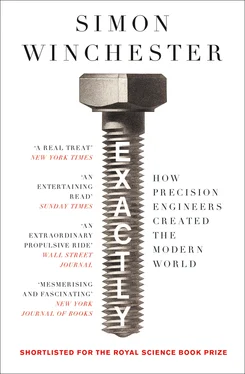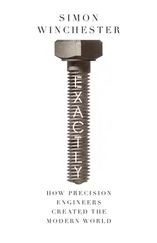It has taken decades to design the scientific instruments that are secreted out in the middle of this dust-dry nowhere. “We maintain our security by our obscurity” is the motto for those who fret about the costly experiments sited there, all without a fragment of barbed wire or chain link to protect them. The tolerances of the machines at the LIGO site are almost unimaginably tiny, and the consequent precision of its components is of a level and nature neither known nor achieved anywhere else on Earth.
LIGO is an observatory, the Laser Interferometer Gravitational-Wave Observatory. The purpose of this extraordinarily sensitive, complex, and costly piece of equipment is to try to detect the passage through the fabric of space-time of those brief disruptions and distortions and ripples known as gravitational waves, phenomena that in 1916 Albert Einstein predicted, as part of his general theory of relativity, should occur.
If Einstein was right, then once every so often, when huge events occur far out in deep space (the collision of a pair of black holes, for instance), the spreading fan of interstellar ripples, all moving at the speed of light, should eventually hit and pass through the Earth and, in doing so, cause the entire planet to change shape, by an infinitesimal amount and for just the briefest moment of time.
No sentient being would ever feel such a thing; and the slight squeezing would be so minute and momentary and harmless that not a trace could ever be recorded by any machine or device known—except, in theory, by LIGO. And after decades of experiments with instruments that were being ever more refined to greater and greater degrees of sensitivity, the devices now running in the high northwest desert of Washington State and down in the bayous of Louisiana, where the second such observatory has been built, have indeed brought home the bacon.
For, in September 2015, almost a century after Einstein’s theory was first published, and then again on Christmas Eve that same year and then again in 2016, LIGO’s instruments showed without doubt that a series of gravitational waves, arriving after billions of years of travel from the universe’s outer edges, had passed by and through Earth and, for the fleeting moment of their passage, changed our planet’s shape.
TO DETECT THIS, the LIGO machines had to be constructed to standards of mechanical perfection that only a few years before were well-nigh inconceivable and that, before then, were neither imaginable nor even achievable. For it was not always so, this delicacy, this sensitivity, this ultraprecise manner of doing things. Precision was not always there, waiting in the shadows, needing to be found and then exploited for what its early admirers believed would be the common good. Far from it.
Precision was a concept that was invented, quite deliberately, out of a single and well-recognized historic need. It was brought into being for severely practical reasons—reasons that had much to do not with any dreamy twenty-first-century wish to confirm (or otherwise) the existence of vibrations from the collisions of distant stars. Rather, it had to do with a down-to-earth eighteenth-century realization of what was then a pressing matter of physics, and which was related to the potentially awesome power of that high-temperature form of water that since the century before had been known as and defined by the word steam .
Precision’s birth derives from the then-imagined possibility of maybe holding and managing and directing this steam, this invisible gaseous form of boiling water, so as to create power from it, and to demand that by the employment of this power, it perform useful work for the good (perhaps, and with luck) of all humankind.
And all that, what turned out to be one of the most singular of engineering epiphanies, took place in North Wales on a cool May day in 1776—by coincidence, within weeks of the founding of the United States of America, which would eventually make such use of the precision techniques that duly evolved.
That spring day is now generally (though not unanimously) agreed to mark the birth date for the making of the first construction possessed of a degree of real and reproducible mechanical precision—precision that was measurable, recordable, repeatable, and, in this case, created to the tolerance of one-tenth of an inch, or, as it was put at the time, of an English silver coin with a value or worth of just one shilling.
Chapter 1
(TOLERANCE: 0.1)
Stars, Seconds, Cylinders, and Steam
It is the mark of an instructed mind to rest assured with that degree of precision that the nature of the subject admits, and not to seek exactness when only an approximation of the truth is possible.
—ARISTOTLE (384–322 BC), NICOMACHEAN ETHICS
The man who by the common consent of the engineering fraternity is regarded as the father of true precision was an eighteenth-century Englishman named John Wilkinson, who was denounced sardonically as lovably mad, and especially so because of his passion for and obsession with metallic iron. He made an iron boat, worked at an iron desk, built an iron pulpit, ordered that he be buried in an iron coffin, which he kept in his workshop (and out of which he would jump to amuse his comely female visitors), and is memorialized by an iron pillar he had erected in advance of his passing in a remote village in south Lancashire.
Still, a case can also be made that “Iron-Mad Wilkinson,” as he was widely known, had predecessors who can lay near-equal claim to parenthood. One of them was a luckless clockmaker from Yorkshire named John Harrison, who worked just a few decades earlier to create devices that kept near-perfect time; the other, rather unexpectedly to those who suppose precision to be more or less a modern creation, was a nameless craftsman who worked in Ancient Greece some two thousand years before Harrison, and whose triumph of precise craftsmanship was discovered deep in the Mediterranean at the turn of the last century by a group of fishermen out diving for sponges.
The Greek team, diving in the warm waters south of the Peloponnese, close to the small island of Antikythera, found sponges in abundance, as they usually did. Yet this time they found something else: the spars and tumbled beams of a wrecked ship, most probably a Roman-era cargo vessel. Among all the broken wood, they came upon a diver’s dream: a massive trove of marvels of art and luxury, along with, more mysteriously, a telephone directory–size lump of corroded and calcified bronze and wood that was initially discounted and almost discarded as being of little archaeological significance.
Except that after sitting for two years in a drawer in Athens, overlooked and yet all the while patiently drying itself out, the sorry-looking lump fell apart. It sundered itself into three pieces, revealing within, and to the astonishment of all, a mess of more than thirty metallic and cleverly meshing gearwheels. One of these wheels had a diameter almost as wide as the object itself; others were no wider than a centimeter. All had hand-cut triangular teeth—the tiniest wheels had as few as 15; the enormous one had a then-inexplicable 223. It looked as though all the wheels had been cut from a single plate of bronze.
Astonishment at this discovery quickly turned to disbelief, to skepticism, to a kind of puzzled fearfulness among scientists who simply could not believe that even the most sophisticated of Hellenistic engineers had ever been capable of making such a thing. So, for almost half a century, this most intimidating machine—if that is what it was—was locked away again, secured and contained like a deadly pathogen. It was given a name, the Antikythera mechanism, for the island, halfway between Crete and the southern tendrils of mainland Greece, off which it was found. It was then quietly and casually all but erased from a Greek archaeological history that was much more comfortable dealing with the more customary fare of vases and jewelry, amphorae and coins, and statues of marble or the most lustrous bronze. A handful of slim books and pamphlets were published, declaring the device to be some kind of astrolabe or planetarium, but otherwise, there was a near-universal lack of interest in the find.
Читать дальше












